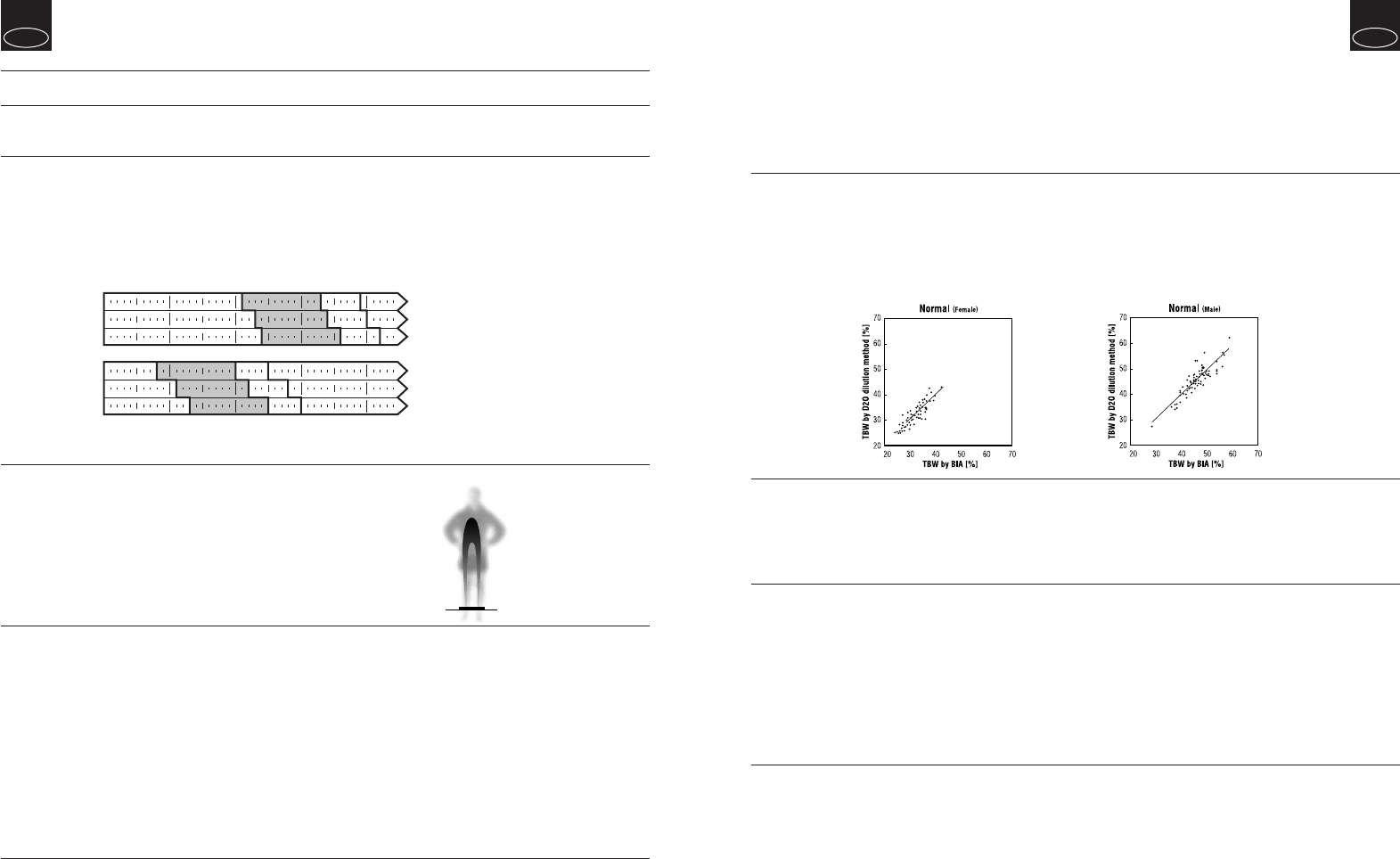
GB
PRINCIPLES OF ESTIMATING BODY FAT PERCENTAGE
Tanita Body Fat Monitor/Scales allow you to determine your body fat
percentage at home as easily as you measure your weight.
What is Body Fat Percentage?
Body fat percentage is the percentage of fat in your body. Too much body
fat has been linked to conditions such as high blood pressure, heart
disease, diabetes, cancer, and other disabling conditions.
The BIA Method
Tanita Body Fat Monitor/Scales use the BIA (Bioelectrical Impedance
Analysis) technique. In this method, a safe, low-level electrical signal is
passed through the body. It is difficult for the signal to flow through fat in
the human body, but easy to flow through moisture in the muscle and other
body tissues. The difficulty with which a signal flows through a substance
is called impedance. So the more resistance, or impedance, the signal
encounters, the higher the body fat reading.
Hydration FIuctuations
Hydration levels in the body may affect body fat readings. Readings are
usually highest in the early waking hours, since the body tends to be
dehydrated after a long night’s sleep. For the most accurate reading using
BIA, a person should take a body fat percentage reading at a consistent time
of day under consistent conditions.
Besides this basic cycle of fluctuations in the daily body fat readings using
BIA, variations may be caused by hydration changes in the body due to
eating, drinking, menstruation, illness, exercising, and bathing. Daily body
fat readings are unique to each person, and depend upon one’s lifestyle, job
and activities.
20–39
40–59
60–79
Healthy Overfat ObeseUnderfat
Healthy Overfat ObeseUnderfat
Based on NIH/WHO BMI Guidelines.
As reported by Gallagher, et al,
at NY Obesity Research Center.
To determine the percentage of body fat
that is appropriate for your body,
consult your physician.
10%0% 20% 30% 40%
20–39
40–59
60–79
Female
Body Fat Ranges for Standard Adults
Age
Male
Age
1, 2
1
2
Tanita’s patented “foot-pad”
design sends a safe, low-
level electrical signal
through the body to
determine its composition.
3
GB
2
What is Total Body Water Percentage?
Total Body Water Percentage is the total amount of fluid in a person’s body expressed as a percentage of their total weight.
Approximately 50 –65% of the weight of a healthy person is water. Water plays a vital role in many of the body’s processes
and is found in every cell, tissue and organ. Maintaining a healthy total body water percentage will ensure the body
functions efficiently and will reduce the risk of developing associated health problems.
How To Measure Total Body Water?
Deuterium Dilution Method is currently used as a typical method to measure a total body water percentage. This
instrument estimates the total body percentage by the analysis (Multiple Regression Analysis) based on the parameter
found by the BIA method.
A mutuality over 0.8 is obtained between this instrument and the “deuterium dilution method”.
Note: Deuterium Dilution Method is in terms of total body water based on the analysis of the dilution of orally ingested deuterium oxide in urine.
Healthy Total Body Water Percentage (%TBW)
The average total body water percentage ranges for a healthy adult are:
Female: 45 to 60%
Male : 50 to 65%
Note: The total body water percentage of a person with a high percentage of body fat may fall below the average healthy ranges.
Daily Rhythm of Total Body Water
Try to measure total body water percentage at the same time of day and under the same conditions. This increases the
accuracy of the readings. The best time is in the early evening, before the evening meal, when hydration levels are more
stable. Total body water percentage tends to be underestimated to a degree if measured immediately after getting out of
bed, not only because of dehydration but also because the fluid in the body will be stored centrally in the body’s trunk.
As the day progresses this fluid becomes more evenly distributed due to the effect of gravity.
On the contrary, it may be overestimated after exercise or taking a bath because of the movement of body water or a rise in
the body temperature despite actual dehydration.
Important Notes
• Take your measurements at the same time of day and under the same conditions.
• Measured results depend on the movement of water in the body and/or changes in body temperature. Factors
affecting total body water levels include sleep, physical activity, eating and drinking, illness and medications, bathing
patterns and urination.
• Take fluid immediately if you have any symptoms of dehydration, particularly after physical activity or bathing.
Symptoms include a dry mouth, headache, nausea, dizziness, skin dryness, a rise in temperature, loss of
concentration, etc. If symptoms persist, consult your doctor immediately.
• Elderly people are at increased risk of dehydration as they have less sensitivity to thirst and other rational symptoms.
• This instrument cannot be used to specifically determine an individual’s recommended total body water percentage.
Look for the long-term changes in total body water percentage and try to maintain a consistent, healthy total body
water percentage.
















